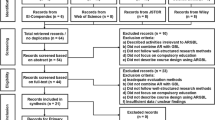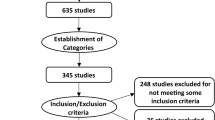Abstract
Augmented Reality (AR) games, in the education sector, have the potential to enable new forms of learning and transform the learning experience. However, it remains unclear how these AR games whose designs are based on diverse game genres can be used to leverage the conventional education process in the context of different theoretical paradigms and models used in learning. This chapter addresses these challenges by providing an analysis of game genres, learning paradigms, theories and models used in different AR games in the field of education. Hence, we present a selected number of previous studies of AR games in the field of education, which are classified by year of publication, school subject, research method, game genres, AR systems, learning environment, learning paradigms and theories, target group(s) and study sample size. The classified data is analysed to identify how AR games designed based on diverse game genres can be used to benefit the educational process in the context of different theoretical paradigms and models used in learning.
Access this chapter
Tax calculation will be finalised at checkout
Purchases are for personal use only
Similar content being viewed by others
Notes
- 1.
Google Play https://play.google.com/.
- 2.
Apple App store https://www.apple.com/ios/app-store/.
- 3.
Vuforia Software Development Kit https://www.vuforia.com/.
- 4.
Apple ARKit https://developer.apple.com/documentation/arkit.
- 5.
Google ARCore https://developers.google.com/ar/.
- 6.
Gartner Hype Cylce for emerging techhnologies 2018, https://www.gartner.com/smarterwithgartner/5-trends-emerge-in-gartner-hype-cycle-for-emerging-technologies-2018/.
- 7.
Google expeditions: https://edu.google.com/products/vr-ar/?modal_active=none.
References
Alakarppa I, Jaakkola E, Vayrynen J, Hakkila J (2017) Using nature elements in mobile ar for education with children, p 41
Anderson JR, Reder LM, Simon HA (1996) Situated learning and education. Educ Res 25(4):5–11
Ashworth F, Brennan G, Egan K, Hamilton R, S ́aenz O (2004) Learning theories and higher education. Level 3 2(1):4
Assila A, de Oliveira KM, Ezzedine H (2014) Towards qualitative and quantitative data integration approach for enhancing HCI quality evaluation pp 469–480
Boeree CG (2000) Behaviorism. http://webspace.ship.edu/cgboer/beh.html
Boletsis C, McCallum S (2013) The table mystery: an augmented reality collaborative game for chemistry education, pp 86–95
Brown JS (2006) New learning environments for the 21st century: exploring the edge. Chang Mag High Learn 38(5):18–24
Chatzidimitris T, Kavakli E, Economou M, Gavalas D (2013) Mobile augmented reality edutainment applications for cultural institutions, pp 1–4
Chong Y, Wong M, Thomson Fredrik E (2005) The impact of learning styles on the effectiveness of digital games in education
de Sainte-Foy C (2015) Observation and analysis of a classroom teaching and learning practice based on augmented reality and serious games on mobile platforms
Deterding S, Sicart M, Nacke L, O’Hara K, Dixon D (2011) Gamification. Using game-design elements in non-gaming contexts, pp 2425–2428
Echeverria A, Amestica M, Gil F, Nussbaum M, Barrios E, Leclerc S (2012) Exploring different technological platforms for supporting co-located collaborative games in the classroom. Comput Hum Behav 28(4):1170–1177
Edutech wiki (2016) Incidental learning. http://edutechwiki.unige.ch/en/Incidental_learning
Eishita FZ, Stanley KG, Mandryk R (2014) Iterative design of an augmented reality game and level-editing tool for use in the classroom, pp 1–4
Fitz-Walter Z, Tjondronegoro D, Koh D, Zrobok M (2012) Mystery at the library: encouraging library exploration using a pervasive mobile game, pp 142–145
Furio D, Gonzalez-Gancedo S, Juan MC, Seguı I, Costa M (2013a) The effects of the size and weight of a mobile device on an educational game. Comput Educ 64:24–41
Furio D, Gonzalez-Gancedo S, Juan MC, Seguı I, Rando N (2013b) Evaluation of learning outcomes using an educational iphone game vs. traditional game. Comput Educ 64:1–23
Hodhod R (2014) Adaptive augmented reality serious game to foster problem solving skills
Hsu TC (2017) Learning English with augmented reality: do learning styles matter? Comput Educ 106:137–149
Hubbard R (2012) What is goal-based learning? https://robhubbard.wordpress.com/2012/10/03/what-is-goal-based-learning
Hwang GJ, Wu PH, Chen CC, Tu NT (2016) Effects of an augmented reality-based educational game on students’ learning achievements and attitudes in real-world observations. Interact Learn Environ 24(8):1895–1906
Jan M (2009) Desiging an augmented reality game-based curriculum for argumentation. Doctoral dissertation, University of Wisconsin–Madison
Jensen E (2008) Brain-based learning: The new paradigm of teaching. Corwin Press
Innovative Learning (2011) Cognitivism. http://www.innovativelearning.com/educational_psychology/cognitivism/index.htm
Kamarainen AM, Metcalf S, Grotzer T, Browne A, Mazzuca D, Tutwiler MS, Dede C (2013) Ecomobile: integrating augmented reality and probeware with environmental education field trips. Comput Educ 68:545–556
Karagiorgas DN, Niemann S (2017) Gamification and game-based learning. J Educ Technol Syst 45(4):499–519
Kjeldskov J, Paay J (2012) A longitudinal review of mobile HCI research methods, pp 69–78
Kop R, Hill A (2008) Connectivism: learning theory of the future or vestige of the past? Int Rev Res Open Distrib Learn 9(3)
Laine TH, Suk HJ (2016) Designing mobile augmented reality exergames. Games Cult 11(5):548–580
Lin CY, Chai HC, Jy Wang, Chen CJ, Liu YH, Chen CW, Lin CW, Huang YM (2016) Augmented reality in educational activities for children with disabilities. Displays 42:51–54
Laine TH, Nygren E, Dirin A, Suk HJ (2016) Science spots AR: a platform for science learning games with augmented reality. Educ Technol Res Dev 64(3):507–531
Lateef F (2010) Simulation-based learning: just like the real thing. J Emergencies, Trauma Shock 3(4):348
Lowe NK (1988) Games and toys in the teaching of science and technology. UNESCO/Division of Science and Environmental Education. http://www.unesco.org/education/pdf/325_41.pdf
Math Solutions (2016) What is scaffold learning? https://mathsolutions.com/uncategorized/what-is-scaffold-learning/
Nilsson S, Arvola M, Szczepanski A, B ̊ang M (2012) Exploring place and direction: mobile augmented reality in the astrid lindgren landscape, pp 411–419
Oppermann L, Blum L, Shekow M (2016) Playing on AREEF: evaluation of an underwater augmented reality game for kids, pp 330–340
Pak R (2011) Engaging classroom games for all grades. http://www.teachhub.com/engaging-classroom-games-all-grades
Pombo L, Marques MM, Carlos V, Guerra C, Lucas M, Loureiro MJ (2017) Augmented reality and mobile learning in a smart urban park: pupils perceptions of the EduPARK game, pp 90–100
Prensky M (2003) Digital game-based learning. Comput Entertain (CIE) 1(1):21
Prensky M (2004) The emerging online life of the digital native. Retrieved 7 Aug 2008
Rapeepisarn K, Wong KW, Fung CC, Khine MS (2008) The relationship between game genres, learning techniques and learning styles in educational computer games, pp 497–508
Revelle G, Reardon E, Cook K, Takeuchi L, Ballagas R, Mori K, Horii H, Raffle H, Sandberg M, Spasojevic M (2014) Electric agents: combining collaborative mobile augmented reality and web-based video to reinvent interactive television. Comput Entertain (CIE) 12(3):1
Rogers K, Frommel J, Breier L, Celik S, Kramer H, Kreidel S, Brich J, Riemer V, Schrader C (2015) Mobile augmented reality as an orientation aid: a scavenger hunt prototype, pp 172–175
Rosenbaum E, Klopfer E, Perry J (2007) On location learning: Authentic applied science with networked augmented realities. J Sci Educ Technol 16(1):31–45
Santoso M, Yan WF, Gook LB (2012) Development of edutainment content for elementary school using mobile augmented reality. In: 4th International Conference on Computer Research and Development IPCSIT 39:14–21
Savery JR, Duffy TM (1995) Problem based learning: an instructional model and its constructivist framework. Educ Technol 35(5):31–38
Schell J (2014) The art of game design: a book of lenses. AK Peters/CRC Press, Natick
Simply Psychology (2015) Humanism. https://www.simplypsychology.org/humanistic.html
Squire K, Klopfer E (2007) Augmented reality simulations on handheld computers. J Learn Sci 16(3):371–413
Squire KD, Jan M (2007) Mad city mystery: developing scientific argumentation skills with a place-based augmented reality game on handheld computers. J Sci Educ Technol 16(1):5–29
Tobar-Mũnoz H, Baldiris S, Fabregat R (2017) Augmented reality game-based learning: enriching students experience during reading comprehension activities. J Educ Comput Res 55(7):901–936
Tolman EC (1922) A new formula for behaviourism. Psychol Rev 29(1):44
University of Sydney (2011) Constructivism. http://sydney.edu.au/education_social_work/learning_teaching/ict/theory/constructivism.shtml
Viinikkala L, Korkalainen T, Arimaa J, Lehtonen T, Helle S (2014) The luostarinmaki adventure- an augmented reality game in an open-air museum. Engag SpacES, 231
Wikipedia (2012) Challenge-based learning. https://en.wikipedia.org/wiki/Challenge-based_learning
Wikipedia (2014) List of video game genres. https://en.wikipedia.org/wiki/List_of_video_game_genres
Wikipedia (2016a) Experiential learning. https://en.wikipedia.org/wiki/Experiential_learning
Wikipedia (2016b) Inquiry-based learning. https://en.wikipedia.org/wiki/Inquiry-based_learning
Wikiversity (2017) Contextual learning. https://en.wikiversity.org/wiki/ContextualLearning
Williams B (2005) Case based learning: a review of the literature: is there scope for this educational paradigm in prehospital education? Emerg Med J 22(8):577–581
Yeo HS, Minami R, Rodriguez K, Shaker G, Quigley A (2018) Exploring tangible interactions with radar sensing. In: Proceedings of the ACM on Interactive, Mobile, Wearable and Ubiquitous Technologies 2, 4, Article 200 (December 2018)
Young JC, Kristanda MB, Hansun S (2016) Armatika: 3D game for arithmetic learning with augmented reality technology, pp 355–360
Zarzuela MM, Pernas FJD, Mart ́ınez LB, Ortega DG, Rodr ́ıguez MA (2013) Mobile serious game using augmented reality for supporting children’s learning about animals. Procedia Comput Sci 25:375–381
Acknowledgements
The authors acknowledge the European Commission for funding the InnoRenew CoE project (Grant Agreement 739574) under the Horizon 2020 Widespread-Teaming program and the Republic of Slovenia (Investment funding of the Republic of Slovenia and the European Union of the European regional Development Fund). The research was also supported by Slovenian research agency ARRS (P1–0383 and J1–9186).
Author information
Authors and Affiliations
Corresponding author
Editor information
Editors and Affiliations
Appendix 1: AR Games in Education
Appendix 1: AR Games in Education
https://docs.google.com/document/d/1-RsE1C-AoPOnnAe9FfDQaRG18HCLyB14QD31vfKmDes/edit?usp=sharing
Rights and permissions
Copyright information
© 2019 Springer Nature Switzerland AG
About this chapter
Cite this chapter
Weerasinghe, M., Quigley, A., Ducasse, J., Čopič Pucihar, K., Kljun, M. (2019). Educational Augmented Reality Games. In: Geroimenko, V. (eds) Augmented Reality Games II. Springer, Cham. https://doi.org/10.1007/978-3-030-15620-6_1
Download citation
DOI: https://doi.org/10.1007/978-3-030-15620-6_1
Published:
Publisher Name: Springer, Cham
Print ISBN: 978-3-030-15619-0
Online ISBN: 978-3-030-15620-6
eBook Packages: Computer ScienceComputer Science (R0)




